
2024: A Year Full of Shows for Sepro Group!
Mar 14, 2024
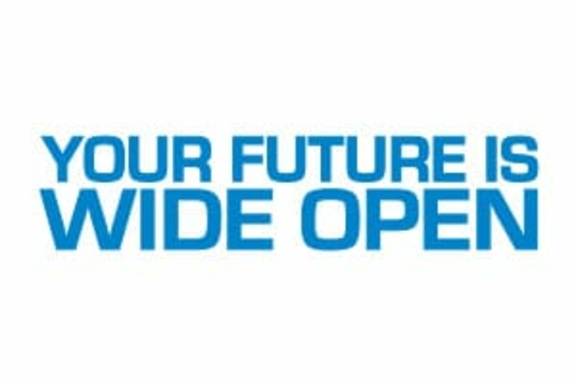
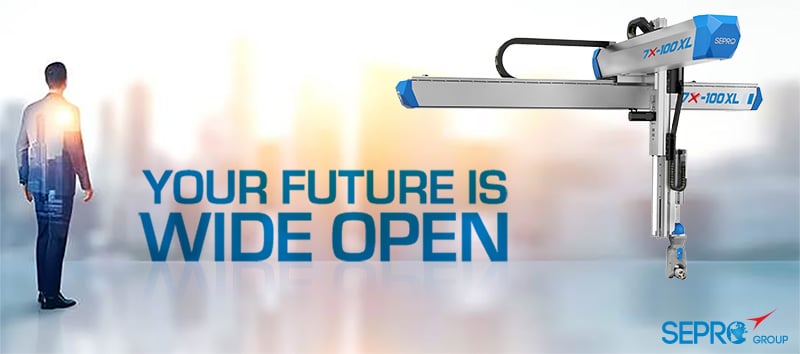 The “brain” of the robot already collaborates in a master/slave relationship with other machines and can react automatically in real time to adapt to programming and sensory inputs. Thanks to Euromap and SPI communications protocols and the latest robot controls – including Visual controls from Sepro – it is already possible to automate any molding machine from any manufacturer, whether new or previously installed. In fact, a recent survey found Sepro robots working on more than 30 different brands of molding machines.
The “brain” of the robot already collaborates in a master/slave relationship with other machines and can react automatically in real time to adapt to programming and sensory inputs. Thanks to Euromap and SPI communications protocols and the latest robot controls – including Visual controls from Sepro – it is already possible to automate any molding machine from any manufacturer, whether new or previously installed. In fact, a recent survey found Sepro robots working on more than 30 different brands of molding machines.
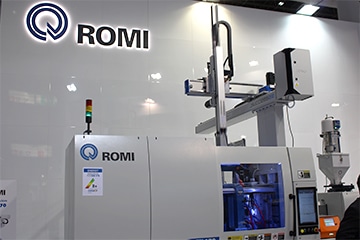 Of course, that communications technology will become more advanced, and we are seeing the introduction of collaborative robots or co-bots that can work side-by-side with humans in some cases. However, we need to think of Industry 4.0 in broader terms. At Sepro, we believe the real Industry 4.0 will see communication, integration and collaboration not only between machines, but also between people and between companies around the world. That is what will take industry to the next level. That is what will create the factories of the future.”
Of course, that communications technology will become more advanced, and we are seeing the introduction of collaborative robots or co-bots that can work side-by-side with humans in some cases. However, we need to think of Industry 4.0 in broader terms. At Sepro, we believe the real Industry 4.0 will see communication, integration and collaboration not only between machines, but also between people and between companies around the world. That is what will take industry to the next level. That is what will create the factories of the future.”
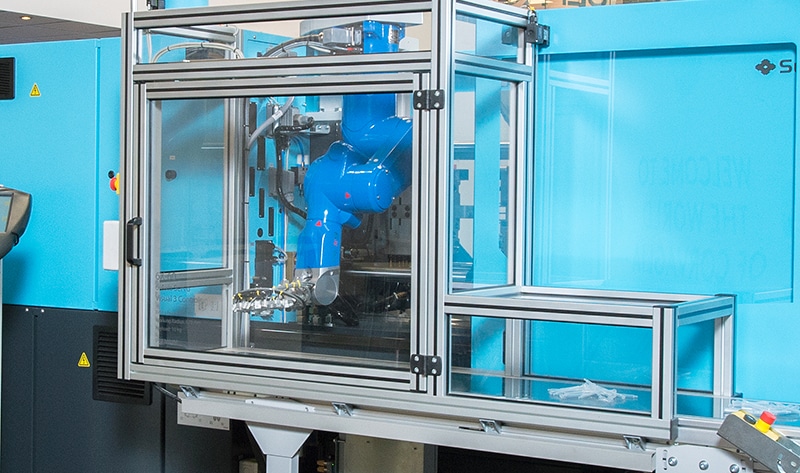 Sepro Robot on Sumitomo Demag IMM at K2016.[/caption]
Today, Sepro is collaborating with various IMM partners to offer three different levels of control integration:
Sepro Robot on Sumitomo Demag IMM at K2016.[/caption]
Today, Sepro is collaborating with various IMM partners to offer three different levels of control integration:
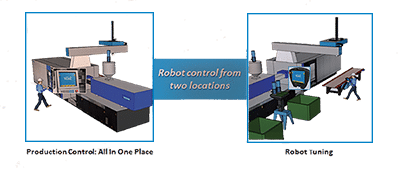 The robot control can be mirrored on the operator panel of the injection molding machine.
The IMM doesn’t control the robot, but it does provide the interface to the robot control. In this configuration, it is possible to control the robot from two different locations. For instance, on the operator side of the machine, the machine control interface can be used and on the back of the machine, the robot control pendant can be used. This can greatly simplify the fine-tuning of robot movements without the operator having to move back and forth from one side of the machine to the other.
The robot control can be mirrored on the operator panel of the injection molding machine.
The IMM doesn’t control the robot, but it does provide the interface to the robot control. In this configuration, it is possible to control the robot from two different locations. For instance, on the operator side of the machine, the machine control interface can be used and on the back of the machine, the robot control pendant can be used. This can greatly simplify the fine-tuning of robot movements without the operator having to move back and forth from one side of the machine to the other.
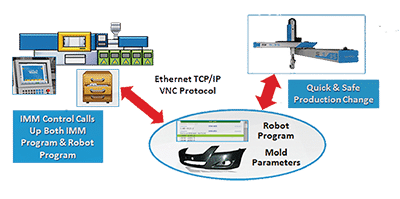 Here, the robot application program is fully integrated in the IMM control and all application data, including robot programming and possibly other auxiliary equipment like mold temperature controls, are filed in one place in the IMM control memory. Operation is similar to Level 2, but this configuration files and backs up application parameters of the entire cell in one single archive.
This arrangement is best for molders that want to centralize management of plant production and prevent any chance of a conflict between robot and machine controls.
This integration technology is already reality, as each of these configurations has been implemented to some degree with certain Sepro partners.
We’ve also been told that Industry 4.0 will see different machines working together as a unit. Increasingly, processors are discovering that they can, in fact, improve productivity and make added-value parts when robots collaborate not only with IMMs but other equipment as well.
These include customized, multifunctional end-of-arm tooling, insert feeders and positioning systems, and post-mold inspection, assembly and packaging equipment that yield specific solutions in:
Here, the robot application program is fully integrated in the IMM control and all application data, including robot programming and possibly other auxiliary equipment like mold temperature controls, are filed in one place in the IMM control memory. Operation is similar to Level 2, but this configuration files and backs up application parameters of the entire cell in one single archive.
This arrangement is best for molders that want to centralize management of plant production and prevent any chance of a conflict between robot and machine controls.
This integration technology is already reality, as each of these configurations has been implemented to some degree with certain Sepro partners.
We’ve also been told that Industry 4.0 will see different machines working together as a unit. Increasingly, processors are discovering that they can, in fact, improve productivity and make added-value parts when robots collaborate not only with IMMs but other equipment as well.
These include customized, multifunctional end-of-arm tooling, insert feeders and positioning systems, and post-mold inspection, assembly and packaging equipment that yield specific solutions in:
 For instance, Sepro is collaborating with the Robotics Institute at Carnegie Mellon University in Pittsburgh, PA, to develop the next generation of robot and injection-molding machine controls. The project is still in the development phase, but it is likely that the new controls will feature elements like ‘agile’ ergonomics, similar to tablets, the ability to ‘learn by doing,’ 3D simulation to make programming easier, extensive customization, and ‘apps’ to facilitate routine functions like maintenance and troubleshooting.
For instance, Sepro is collaborating with the Robotics Institute at Carnegie Mellon University in Pittsburgh, PA, to develop the next generation of robot and injection-molding machine controls. The project is still in the development phase, but it is likely that the new controls will feature elements like ‘agile’ ergonomics, similar to tablets, the ability to ‘learn by doing,’ 3D simulation to make programming easier, extensive customization, and ‘apps’ to facilitate routine functions like maintenance and troubleshooting.
 However, collaboration cannot be confined within one industry. So, Renaudeau is actively involved in developing innovative management practices with Audencia Business School in Nantes, one of the top business schools in France and in Europe. The school has 3470 students from over 80 countries in its bachelors, international and specialized masters, MBA, doctoral and executive education programs.
Sepro CEO Jean-Michel Renaudeau calls this “crossing the border.” When people and companies share resources, he says, they develop a more global view. They gain information and understanding that allows them to become stronger quicker. He points to his own company as an example of how these kinds of connections ultimately benefit plastics injection molders. “How does a relatively small company like Sepro, in the middle of nowhere in western France, become a global leader in robotics and automation,” he asks?
However, collaboration cannot be confined within one industry. So, Renaudeau is actively involved in developing innovative management practices with Audencia Business School in Nantes, one of the top business schools in France and in Europe. The school has 3470 students from over 80 countries in its bachelors, international and specialized masters, MBA, doctoral and executive education programs.
Sepro CEO Jean-Michel Renaudeau calls this “crossing the border.” When people and companies share resources, he says, they develop a more global view. They gain information and understanding that allows them to become stronger quicker. He points to his own company as an example of how these kinds of connections ultimately benefit plastics injection molders. “How does a relatively small company like Sepro, in the middle of nowhere in western France, become a global leader in robotics and automation,” he asks?
This vision of Industry 4.0, what Renaudeau refers to as “the commons sense view,” and Sepro’s commitment to it, has allowed us has been able to make big things happen in a short period of time. It can help plastic injection molders make great strides too. They will certainly discover that, thanks to today’s robots and evolving technology, the future is wide open.“Industry 4.0 is not just about technology that allows machines to communicate. That’s a part of it, but more importantly it is about people and companies multiplying our own capabilities through collaboration and a shared vision of the future. Why else are auto companies like Ford actively working with service companies like Uber?”
Receive a summary of our news and events every month